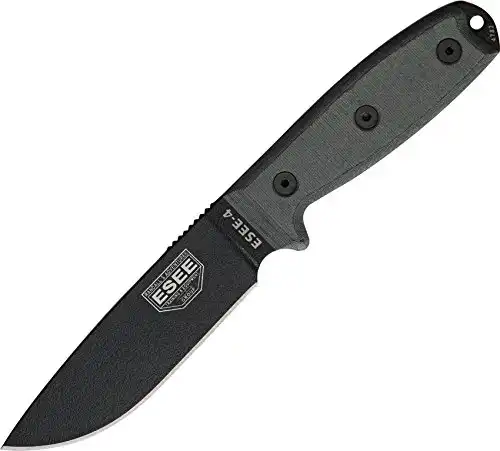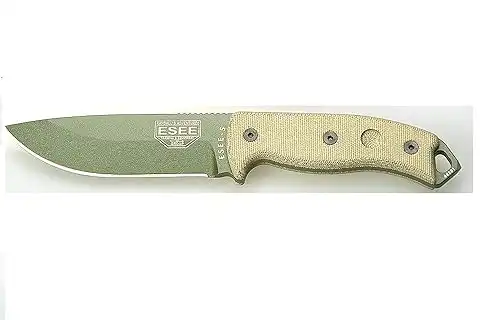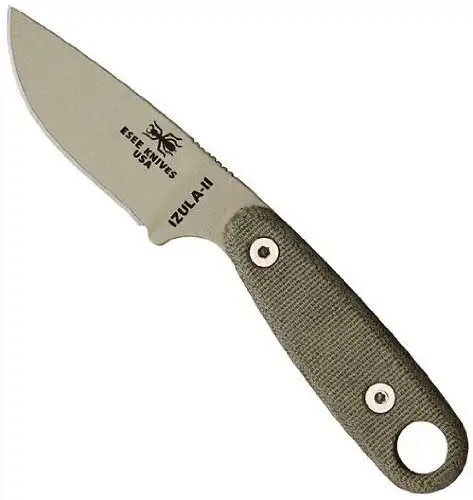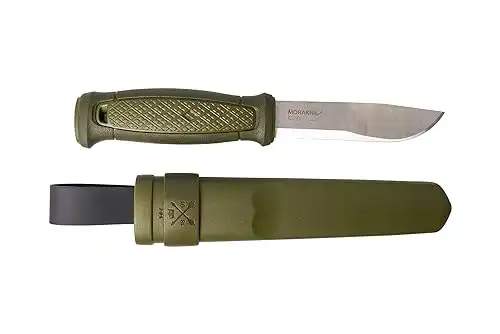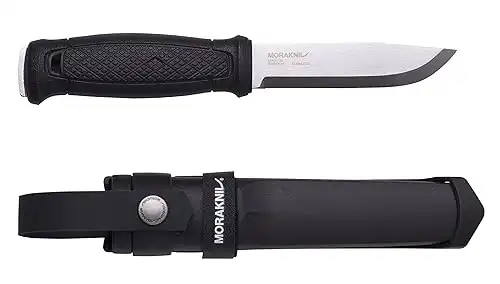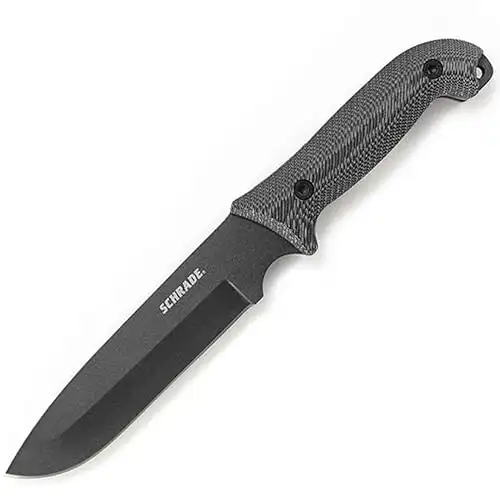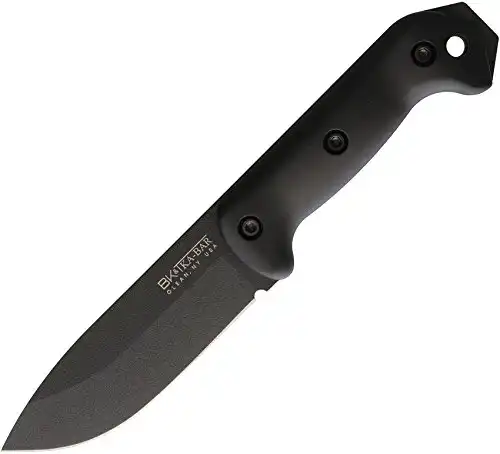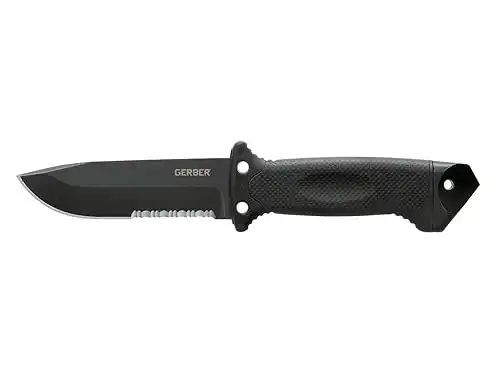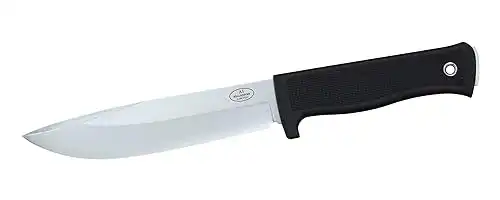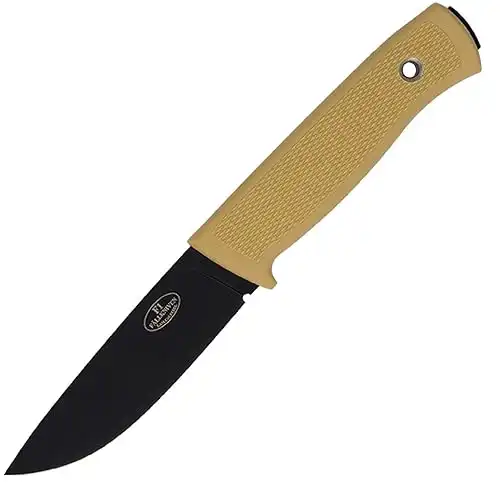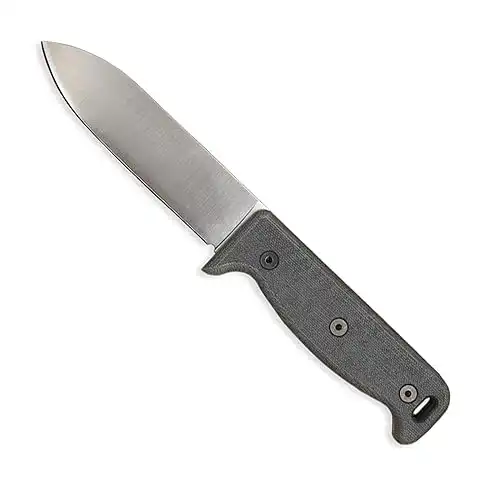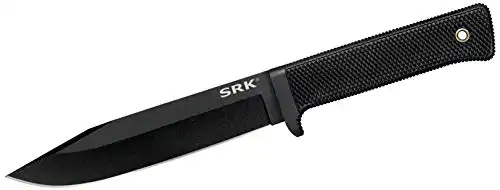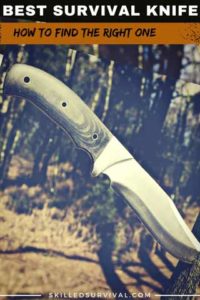
A Complete Guide On Finding The Best Survival Knife For You
Because today, survival knives come in a nearly infinite number of:
- Shapes
- Sizes
- Designs
- And Styles
But with so many, it’s hard to know which one is the “BEST”…
And we all know “BEST” is a 4 letter word, right?
Best for WHAT? Best for WHO?
So today, I’ll cut through the confusion and find a survival knife you be proud of…
TOPICS IN THIS GUIDE… ↓(click to jump)
- Best Survival Knives Today
- Best Survival Knife Features
- 8 Key Knife Design Choices
- 1. Blade Design
- 2. Fixed vs. Folding
- 3. Blade Length
- 4. Blade Steel
- 5. Blade Grind
- 6. Tang Construction
- 7. Blade Coatings
- 8. Grip Techniques
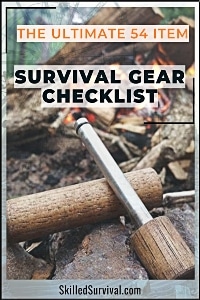
Want a free 54 item survival gear checklist?
Click here to instantly download this Complete Checklist PDF. No purchase necessary.Best Survival Knives For Sale Today
The ESEE Model 4 was designed as an all-around tactical, survival, and bushcraft knife.
The minimalist design features full-tang construction, tough micarta or polymer grip scales, and easy to service hex-key screws. This makes it extremely durable and reliable.
It's built of high-carbon 1095 steel, a great choice for all kinds of blades.
Many people will be tempted to go for a larger blade, but the 4-inch blade is perfect for the majority of tasks.
It holds an edge well and sharpens easily, though you do have to take care to keep it clean and lightly lubricated to prevent staining or rust.
The supplied sheaths seem to have varied over the production run, with some of the older versions missing the MOLLE attachments. Other versions sported a molded leather sheath which holds the knife securely in place.
The most recent version has a simple poly sheath, but ESEE still sells the Kydex sheath separately and at a reasonable price.
PROS
- High quality 1095 steel blade
- Minimalist design with few weaknesses
- 4in blade is perfect for most knife tasks
- Lifetime warranty
CONS
- The blade does require regular maintenance
- Different sheath designs may or may not include MOLLE attachments
↓ ESEE 4 Knife
If the ESEE 4 just isn't enough blade for you, ESEE still has plenty of models with a bit more heft.
The ESEE 5 is a solid survival and utility knife, with a 5.25" blade carved from a single 1/4" thick full-tang slab of high-carbon 1095 steel that's over 1.5" wide.
This gives the ESEE 5 an amazing level of durability for the heaviest chopping and batoning tasks.
The micarta handle scales are screwed on with hex key bolts, allowing you to fully service (and clean) your knife.
The scales also feature a bow drill divot.
Designed to give you a secure point from which to apply pressure downward on the drill shaft when starting a fire.
It's an excellent detail and WAY more secure than trying to find a rock or shell with a natural divot.
The heavy steel blade also features an extra survival detail - the pommel is a hardened point for breaking glass!
PROS
- Glass breaker on the pommel
- Bow drill divot in the handle
- High quality 1095 carbon steel
- Durable micarta handles and Kydex sheath
CONS
- Overall length (11in) might be unwieldy
- Weight (16oz) is more than other similar sized blades
- High carbon steel requires regular maintenance
↓ ESEE-5 Knife
When it comes to survival knives, bigger isn't always better.
The ESEE Izula-II is a perfect example of an EDC survival knife. Easy to carry, it's the blade you can always have with you.
With a 2.625" cutting edge and an overall length of only 6.25", it's one of the more compact knives in its class.
But that doesn't mean ESEE skimps on the features or construction
The Izula-II is built on a full-tang piece of high carbon 1095 steel, a great choice for all kinds of blades. It takes an edge well and is easy to sharpen.
The micarta scales are removable, in case you need to clean or repair them - but it also means you can strip the knife down and do a paracord wrap handle if you want.
However, the handle design is one of the key features of the Izula-II, making it easy to hold and work with on even the most delicate tasks (food prep, skinning, etc.), so I wouldn't suggest that option unless you really want extra paracord on hand.
PROS
- Compact and easy to conceal
- High quality 1095 steel blade
- Replaceable grip scales
CONS
- The sheath does not include a belt clip
- High carbon steel requires regular maintenance to prevent rust
↓ ESEE Izula II
If you're looking for a high-quality stainless steel survival knife, the Morakniv Kansbol is a great option. It's a versatile blade, built of the highest grade Swedish 12C27 stainless steel.
Right out of the box, the Kansbol is razor-sharp and exceptionally resistant to the rust and corrosion that plagues many knives. Stainless steel is also very hard, making it more difficult to ding or dull your blade.
The back of the blade is ground to a 90-degree edge, making a perfect surface to strike sparks and save wear and tear on the blade edge.
The tough polyamide injection molded handle and sheath are easy to grip and built to last.
They work well together, forming a click-lock closure that keeps the knife from accidentally falling out while on the move. In fact, there are two sheath options to choose from, depending on how you want to mount the knife.
PROS
- Highly resistant to corrosion
- Durable handle and sheath
- Holds an edge well
- Lightweight for blade size
- Multiple sheath options
Cons
- Not a full tang design (partial tang)
- Stainless is hard to sharpen
↓ Morakniv Mora Kansbol
If you've looked into other Morakniv stainless steel survival knives, you know some of the benefits of a high-quality stainless blade. The Garberg takes all those benefits a few steps further.
It's built on a full-tang slab of 14C28N stainless steel, extending 9 inches from the tip of the blade to the exposed pommel. This gives it unmatched durability and simplicity, with fewer parts to break.
The stainless steel comes razor sharp out of the box and will hold that edge for a long time, without corrosion or dulling. Like all stainless steel blades, you may find it more difficult to sharpen at home.
Similar to other Morakniv blades, the spine of the blade is square-ground to provide a good edge for sparking fire starters, which prevents damage to the sharp edge.
The Garberg also comes with one of three choices in sheath design, from a classic leather flap sheath to polymer belt or MOLLE compatible versions.
PROS
- High-quality stainless steel resists corrosion
- Multiple sheath options
- Holds an edge well
CONS
- Hard to sharpen
- The handle is bulky, harder to hold if you have small hands
↓ Mora of Sweden Garberg
Coming in somewhere between "knife" and "machete", the Schrade SCH9 is over 12" of full-tang steel with a (semi) kukri blade shape.
I say "semi" because there is little of the characteristic crook bend of a kukri, but the drop tip blade does have a large curve in the belly which puts the center of mass of the knife more towards the tip.
This makes it an efficient chopping knife for clearing brush, felling limbs and sharpening sticks, and splitting kindling. The blade is made of high-carbon 1095 steel, a great choice for all kinds of blades.
It takes an edge well and can be sharpened easily, though it does require regular cleaning and maintenance to prevent corrosion.
The textured elastomer handle is easy to grip and has great positive finger placements to keep the knife firmly in your control. It also makes it easier to use the exposed pommel as an improvised hammer to crack nuts, pound in stakes, or break glass.
The ballistic nylon sheath is workable but flops around a bit without the leg tie. However, I'd prefer a MOLLE compatible sheath and would consider an aftermarket upgrade.
PROS
- Great for heavy chopping tasks
- High quality 1095 steel
- Solid handle design
CONS
- The sheath is cumbersome in hip attachment configuration
- The blade needs regular maintenance to avoid corrosion
↓ Schrade SCHF9 Knife
The Schrade SCHR52M Frontier is a BIG knife, there's no doubt about it.
The 7" drop point blade is solidly built and up to all the heavy tasks you may find around camp. The high carbon 1095 steel holds a great edge and is a pleasure to sharpen.
At 13" overall and nearly 18oz, it has the mass needed for chopping, splitting, and hacking at vegetation. The full-tang design even stands up to batoning and other high impact chores.
The micarta scales provide a great grip, while a large finger guard keeps your hand from slipping on to the blade. A lanyard hole means you can attach a paracord loop to clip off and keep from dropping the knife.
The polyester belt sheath is serviceable and holds the blade securely as well as the included Ferro rod firestarter and sharpening stone, but it's not the most ergonomic or durable design. A MOLLE-compatible sheath would be a good addition and there are plenty available as replacements.
Finally, there have been some reports of QC issues from the company, but returns and warranty coverage have been good.
PROS
- Solidly build full-tang design
- Large
CONS
- Heavy
- The sheath isn't the greatest
↓ Schrade Frontier
↓ Ka-Bar Becker Companion
Gerber has been around for over 100 years, starting out in Portland Oregon in 1910.
The Gerber LMF was designed in cooperation with former military weapons experts and field-tested by US troops. This means you can trust the 10" knife to stand up to the most rugged use.
The design gives you both fine cutting straight blade for slicing and the tough serrated edge to cut the toughest items (like seatbelts and rope).
The over-molded handle provides plenty of grip, ensuring that you don't lose hold on the knife even in the worst conditions. It's large enough to hold even while wearing gloves, but not too bulky for bare-handed use.
The pommel features a pointed stainless steel cap to punch through automotive glass, but it's also separated from the steel of the blade, allowing for insulation to prevent electric shock.
In a unique addition, the LMF II has lashing holes in the handle, designed to tie it securely to the point of a spear. Hopefully, you'll never need it, but it does provide the option for a long-distance weapon in hunting or combat.
PROS
- Lash points for use as a spear
- Comfortable handle
CONS
- Not a true full-tang design
- Hard to sharpen serrated portion of the blade
↓ Gerber LMF II
Fallkniven makes some of the best, most simplified survival knives out there.
They use extremely high-quality materials throughout and the craftsmanship is superb. In the case of the A1, this means a full 11" of laminated vg10 steel, with a 6" finely sharpened drop point blade.
The full-tang blade extends all the way to an exposed pommel, giving the option to use it as a striking surface.
The rubberized handle is very grippy, with a slight diamond pattern. The finger guard is solid and keeps a good amount of material between your fingers and the blade.
The Zytel sheath is simple and protects and secures the blade nicely. It's a rigid sheath, which does make it slightly less comfortable on the hip or thigh, but it does well attached to a pack or strap. Unfortunately, it's not MOLLE compatible.
However, as with any high-quality brand, there are plenty of attempted fakes. Laminated steel blades often show faint lines along the sharpened edge, similar to famous Damascus steel.
The fakes, made of lesser quality steel, often lack the fine striations but are otherwise identical in appearance. These inferior blades are prone to chipping and lose their edge quickly. So be sure to order from reputable dealers and inspect your blades immediately.
PROS
- Great VG10 laminated steel
- Well balanced and solid design
CONS
- Impostors abound
- Expensive
↓ Fallkniven A1
Fallkniven blades have a reputation for super high-quality materials and craftsmanship and the FN78 F1 is no exception.
At just over 8" overall, it's a compact survival knife with no gimmicks. The 4" drop point blade is clean and simple, making it easy to sharpen and maintain. It's perfect for detailed work like skinning and cleaning game. It's not large enough or heavy enough for chopping or batoning kindling.
Built of COS steel, with a full-tang design and an exposed pommel, it's built to last. The 90deg ground back edge makes it easy to strike sparks from a ferrocerium firestarter. The elastomer handle is easy to grip in any condition and doesn't get brittle or tear with age and use. <
Like other Fallkniven blades, there are plenty of impostors for this one. As always, only buy from trusted dealers and be sure to inspect your knife on arrival. Inconsistent blade grinds and poor quality sharpening are the most obvious indications of a fake.
PROS
- Compact and well-balanced blade
- COS steel is less prone to chipping
CONS
- Impostors abound
- Not big enough for chopping tasks
- No sheath included
↓ Fallkniven F1 Survival
Ontario Knife Company makes some very high-quality blades, and the Black Bird SK-5 follows through on that reputation.
A well-built stainless steel knife with a full-tang design, the SK-5 sports a 5" blade, and a 10" overall length.
It's a great mid-size knife for nearly all the usual camp tasks. It might be a little small for batoning, but it chops, slices, and takes care of medium kindling with ease.
The 154 CM stainless steel is highly resistant to corrosion and is built to last. It's impressively hard and holds a fine edge as well. Of course, it can be hard to sharpen yourself.
The synthetic G10 handles are durable and easy to remove for cleaning, but the shape is rather blocky and not the most comfortable design. It IS possible to re-shape them yourself if you want to take the time to get it perfect.
The MOLLE compatible sheath is well built and attaches well, making it convenient to keep your knife anywhere you need it.
PROS
- Stainless steel is corrosion resistant
- Removable scales allow for cleaning and maintenance of the blade
- MOLLEE compatible sheath
CONS
- The handle is somewhat blocky
↓ Blackbird SK5
This bad boy isn't your average run-of-the-mill blade...
It's a testament to what happens when extreme toughness meets meticulous craftsmanship.
The SRK-C boasts a handle length of a solid 4-3/4" made from Kray-Ex – renowned for its durability and comfort.
This leads into an overall length of 10-3/4".
This knife is the standard issue for Navy Seals B.U.D.S. training. Yes, you heard that right. This knife has been put through the paces by the elite and has come out on top.
The Military and Special Forces community swear by it for its unparalleled versatility and durability, even in the harshest, most unforgiving conditions.
tForged from Japanese high-carbon SK-5 steel, this blade brings to the table what most others can only dream of.
Whether you're slicing, dicing, chopping, or carving, this blade remains unyielding and sharp.
The handle features a single quillon finger guard and a deeply checkered Kray-Ex grip. What does this mean? Whether you're in pouring rain, blistering heat, or wearing gloves, this knife stays glued to your hand, ensuring safety and precision with every use.
↓ Cold Steel SRK
Best Survival Knife Features
Let’s highlight the top features to choose a good survival knife.
1. Size Matters
- Too big, you’ll give up the ability to do detailed carving work.
- Too small, and you’ll be compromising important survival skills like chopping, splitting, and batoning.
You need a knife small enough for precision yet large enough for tougher tasks.
That’s roughly in the 9 to 11-inch overall length.
2. Fixed Blade Only
A fixed-blade survival knife is exactly what it sounds like.
The blade of the knife is in a fixed position.
It does not switch, flip, or fold down.
Fewer moving parts mean a more durable knife.
A tough, quality, constructed fixed-blade knife can handle some serious abuse.
For example:
One of the most abusive techniques is batoning.
↓ How To Baton With A Knife Or Machete
Batoning with a knife is a brutal test.
I tried batoning with a high-quality folding knife once and it destroyed the spring with the 3rd strike!
Since you need your knife to last while performing the most rugged survival skills.
So shop in the “fixed blade survival knife” category.
A folder is awesome, and I carry a Kershaw Onion daily.
But they are not advisable for serious survival.
A fixed-blade knife is what you want for survival.
It’s a blade you can stake your life on.
Folder blades have a weakness that fixed blades do not.
They have a pivot joint that makes them foldable, and when you abuse a folding knife, the joint will eventually break.
3. Full Tang Only
The blade’s tang is the metal section wrapped in the knife’s handle.
A true full tang knife profile fills the entire handle with exposed metal around the edges.
While a partial tang knife is where the metal is smaller and inside the handle.
Full tang knives are designed to withstand much more abuse than partial tangs.
If you beat on a partial tang knife, it will eventually come loose and develop play in the handle.
If the handle breaks off, it’s very difficult and dangerous to use a partial tang knife.
While a full tang knife can be wrapped with some 550 paracord and still work nearly as well.
There are also rat-tail tangs and hidden tangs, which are even less durable than partial tangs.
So ideally, you want full tang for survival.
But some partial tangs are decent for survival purposes as well.
The bottom line is:
The more metal in the handle, the better.
Yes, these knives cost a little more, but it’s worth it.
4. Sharp Spear Point Tips (or drop tips)
Many knife designers want to stand out from the crowd…
So they design funky-looking knife blades with insane shapes.
They might look badass or cool.
But they won’t function as well for survival.
Spearpoint or drop points are best for self-defense penetration.
And allow you to perform fine point work.
Unless you’re looking for a blade for your next Halloween custom…
Otherwise, stick with the simple yet effective blade shapes.
Either a spear point or a drop point, and you won’t regret it.
5. Single-Edged Blade
- Single-edged blades have one side of the blade sharpened
- While double-edged blades are sharp on both sides
And in survival, the flat side is as important as the sharp side.
First, it helps with detailed control.
You can slide your thumb safely onto the flat edge.
But this control technique is impossible if the edge is sharp.
Second, a double edge blade works against you when batoning.
You beat down on a sharp blade and lose your striking power.
Third, using fire steel with a flat edge is easier.
A flat 90-degree grind is ideal to generate sparks from a Ferro rod.
6. Flat Handle End
Look for a knife where the butt of the handle can be a makeshift hammer.
So you want the but to be flat and not round.
This allows you to drive tent stakes into the ground.
Or use your knife like a punch.
↓ Top 6 Survival Knife Features

Want a free 54 item survival gear checklist?
Click here to instantly download this Complete Checklist PDF. No purchase necessary.A Deep Dive Behind Knife Designs
Let’s dive deep into all the following details, such as:
- Blade Design
- Fixed vs. Folding
- Blade Length
- Blade Steel
- Blade Grind
- Tang Construction
- Blade Coatings
- Grip Techniques
Blade Design: Choosing The Right Blade
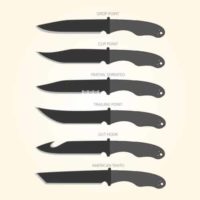
For example:
In survival, you’ll likely use every bit of the blade from the belly to the tip.
There are four main shapes (spear, tonto, clip, or drop point).
For survival, we recommend a spear or drop point.
Because these designs put the tip of the blade close to the centerline.
This results in superior control.
It also lowers the weight at the blade’s tip.
This helps move the knife’s balance point closer to the hilt.
And gives you greater tip control as well.
Plus, you have to decide whether you prefer serrated blades or not…
Here’s an excellent video on blade design options:
↓ Knife Blades 101
Fixed Blade Or Folding? Which Is Best?
Fixed-blade knives are what you want.
- But fixed-blade knives are cumbersome to carry.
- And you can’t carry them around unnoticed.
So for everyday carry get a folder.
They’re better when you’re not trying to build survival shelters or start fires.
You need something durable that won’t break under intense abuse.
Yes, a pocket knife should be in your pocket.
But it should NEVER be your survival knife.
↓ Fixed Blades Vs. Folding Knives
Blade Length: From Short To Long
The length of a knife’s blade determines how useful it is for certain tasks.
- Choppers are your larger machete-like blades.
- For precision bushcraft smaller carver blades are best.
You want a bit of both for survival.
So the best survival blades tend to be in the medium-size range.
↓ Size Matters: Choose The Best Blade Length
Survival Blade Steel: What’s It Make Of?
High carbon steel (i.e., 1095, 5160, 01 or A2) vs. stainless steels (i.e., 420HC, 440C, AUS-8 or AUS-10)
As you can tell, there are a lot of steel options.
In layman’s terms:
High-carbon tool steels are tougher than stainless steel.
This makes them harder to break but less corrosion resistant.
They’re easier to sharpen than stainless.
But their edge retention suffers.
The following video deep dives into all steel options:
↓ How To Choose Steel For Knife Making
Blade Grinds: What’s The Difference?
There are several blade grind options.
Each grind has pros and cons.
However two specific blade grinds stand above the rest.
- The saber grind
- And flat grind
Saber Grind
The saber grind has a short primary bevel from cut edge to the back of the blade.
This creates a thicker edge that’s harder to sharpen.
But will hold its edge better when chopping and splitting.
Flat Grind
The flat grind is a compromise between the saber grind and a hollow grind.
A hollow grind concaves inward from the blade edge to the cutting point.
This makes the cutting edge extremely sharp.
But prone to chipping and damage under intense use.
So a flat grind has a bevel that goes from the cutting edge all the way to the back of the blade.
This allows for a much finer edge than the saber grind.
But is not as fragile as the hollow grind.
If this sounds confusing, watch the videos below:
↓ Knives 101 – Talking About Grinds!
↓ Knife Grinds: Comparing Hollow, Convex, and Flat Grinds
Tang Construction: Full Or Partial?
Invest in a full-tangs ONLY for survival situations.
We discussed it previously so I won’t go over it again.
But if you’re a knife enthusiast look intro to partial tangs (rat tail tang, narrow tangs, hidden tangs).
The following video gives such info:
↓ Tangs: Narrow or Hidden But Never Rat Tail
Blade Coating Options
The science of blade coatings is complex.
But it’s interesting chemistry.
Watch to the end to find out which blade coating holds up best.
↓ Knife Coating Showdown!
Handle Material: Understanding Grips
The grip of a survival knife is critical.
You need a tough grip that won’t break under intense forces.
Yet feels comfortable in your hands.
You also want a grip that won’t absorb moisture.
Because THAT can lead to handling rot.
A few of the most popular knife handle materials are:
- Wood
- Micarta
- G-10
- Zytel
- Krayton
- And Hypalon
The following video dives into these handle materials:
↓ Different Knife Handle Materials
Grip Techniques
Finally, I want to talk grip techniques.
A survival knife is only useful in the right hands.
So watch the following video on knife grips:
↓ How To Choose The Right Knife Grip
Final Thoughts
Survival knives come in all sorts of shapes, sizes, and designs.
You must decide for yourself which is best for your needs.
The good news is:
And you don’t HAVE to choose just one.
Invest in multiple knives.
- Put one in your bug-out bag
- one for your survival pack
- one for your medical first aid kit
- and one for your get-home bag
I don’t know anyone serious about survival who owns just one knife.
Over the years, we accumulated many, each serving a specific purpose.
For example:
Here’s an impressive collection of survival knives:
↓ Basics Of Survival Knives
Why Trust Skilled Survival...
Go here now to review a full breakdown of:
- Who We Are
- Our Credentials
- Our Mission
- & Product Recommendations...
Here are a few highlights of our teams credentials & certifications:
- Certified Member of a Mountain Search & Rescue Organization
- Plant Emergency & Safety Leader for a Major Food Manufacturer
- Member of the 10TH Mountain Division Hut Association
- Certifications: Avalanche 1, WFR, CPR
- Official Gear Tester for Numerous Outdoor Gear Companies
- Countless Multiday Backpacking trips into Remote Wilderness
- Bachelor's Degree In Mechanical Engineering
- Bachelor's Degree In Civil Engineering
- Bachelor's Degree In Biomedical Engineering
"It takes 20 years to build a reputation and five minutes to ruin it." - Warren Buffett
We're fully aware that trust is NOT something you GET but is EARNED.
And we'll continue to earn YOUR trust through our forthright and honest approach with each new Blog Post, Guide & Product we create...
Prepare, Adapt & Overcome,

P.s. Do You Live In A 'Danger Zone' County?
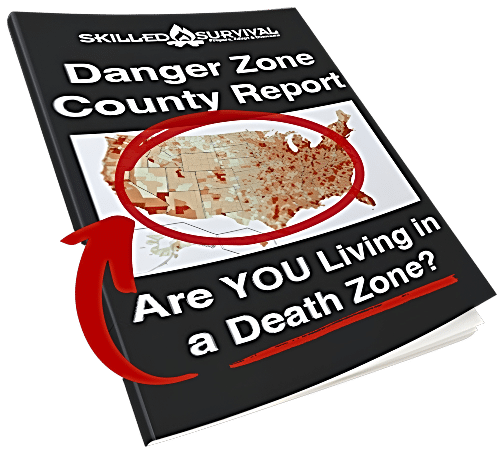
Find out now using my Danger Zone County List & Special Report it’s absolutely FREE.
In minutes you’ll know EXACTLY where you stand and if you should be worried or not..
So click here to get my FREE Danger Zone County List & Report…
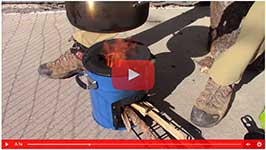
Recommended Reading
LifeStraw Review: An Expert Puts It To The Ultimate Test
LifeStraw Review - with no moving parts, chemical additions, or batteries, it provides a lightweight, compact filter to treat up to 4000L...
Best Survival Bow: 16 Surprising Reasons YOU Should Get One
A survival bow is one of the most underappreciated weapons I think EVERYONE should own. Here are 16 reasons why YOU should get one today.
Best Survival Hatchets: Tough Enough To Outlast The Wild
Not all hatchets are created equal. A quality survival hatchet can do tasks even a survival knife cannot. Here's the one I carry in my pack.
Best Survival Radios: Why You Must Secure One (before SHTF)
Be the ONE who knows what the hell is going on after SHTF. Here's how to set yourself up with a reliable survival radio in a future disaster.
Best EDC Flashlights: Small, Compact But Still Super Bright
The best edc flashlights are durable, bright, compact and worth carrying! In this guide, we review the best one to make your search easy.
11 Proven DIY Survival Gear Projects ANYONE Can Follow
Building DIY survival gear doesn't NEED to be complicated to be effective. Here are the 11 best projects you can finish in just a few hours.
